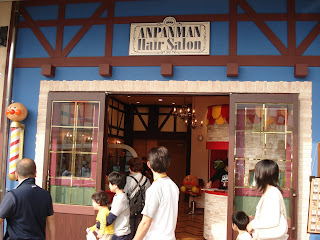
As you can see, I'm backtracking a bit with this post, but quite a few events occurred during the Spring that I wanted to share. Weather-wise, the months were pleasant for the most part. Besides some spring cleaning at home, we were able to visit several different parks without having to worry too much about rain or extremely warm temperatures.
Johoku-Chuo Koen
In this huge open field, Markus loves to run and kick his ball around. There is an oval track for running and a long-jump sand pit, which is usually occupied by young children. We often see students practicing track and field events and doing their group stretching regimens. Because of the vast space, the Johoku-Chuo park also serves as the area's earthquake evacuation site.

Asakusa Koen (near Sensoji Temple)
 Chillin' inside a wooden train car with Kota-kun at Nakadai Koen
Chillin' inside a wooden train car with Kota-kun at Nakadai Koen

On April 17, we celebrated Chihiro-kun's 2nd birthday with an afternoon get-together at Mihoko-san's home.
Otanjoubi Omedeto Chihiro-kun!
(L-R) Mihoko-san, Chihiro-kun and Kota-kun
At the end of April we took another eventful trip to Ueno Zoo. This visit included our friends Hiromi-san and Taro-kun. Anytime you mention anything about a zoo to Markus, his immediate reaction is pure excitement! So of course, he had a great time and the trip was all the more fun having his friend Taro-kun along to enjoy the animal adventure.
Taro-kun observing the amphibians in the Vivarium Building
Taro-kun and Markus loved the Ueno Kodomo Yuen (Children's Amusement Park) outside of the zoo. There are many coin-operated rides, arcade games, and even a small carousel.
Sometimes I swear Markus could be a little tour guide for Ueno Zoo. He memorizes where most of the animal exhibits are! It's so funny!
Panda-san was taking a lazy snooze

Soon after the zoo and amusement park, Hiromi-san and I were strolling along two sleepy-heads by the time we reached the train station.
Otanjoubi Omedeto Addy-chan!
On May 12, we attended Addison Haggerty's 2nd birthday party for cupcakes and ice cream. Markus enjoyed reuniting and playing with his little girlfriend.

In the photo above, Markus is feeding Addy Goldfish crackers...with a spoon!
On May 15, my friend Hiromi-san invited Markus and I, along with other friends from Jidoukan, to her home for a wonderful homemade pizza luncheon. Hiromi-san also baked some fresh bread, some side dishes, and a fabulous fruit salad for dessert.
In the photo above, (L-R) Yoko-san, Asoko-san and Sayaka-san are preparing the pizza.
Freshly baked raisin bread

Taro-kun and Kota-kun chomping down the salad
After lunch, the kids had plenty of time to play around with Taro-kun's toys. We were confined indoors for a while during a severe thunderstorm that afternoon.
Markus' version of a wheelie using Taro-kun's trike
It was almost impossible to get the busy tots to stay orderly for this group photo.
From L-R, Hiromi-san and Taro-kun (the hosts, both wearing orange); directly behind is Keiko-san Masaki-kun; Arisa-chan and Asoko-san; Yoko-san and Ayumi-chan (not visible); Sayaka-san and Kota-kun; Markus and I.











































